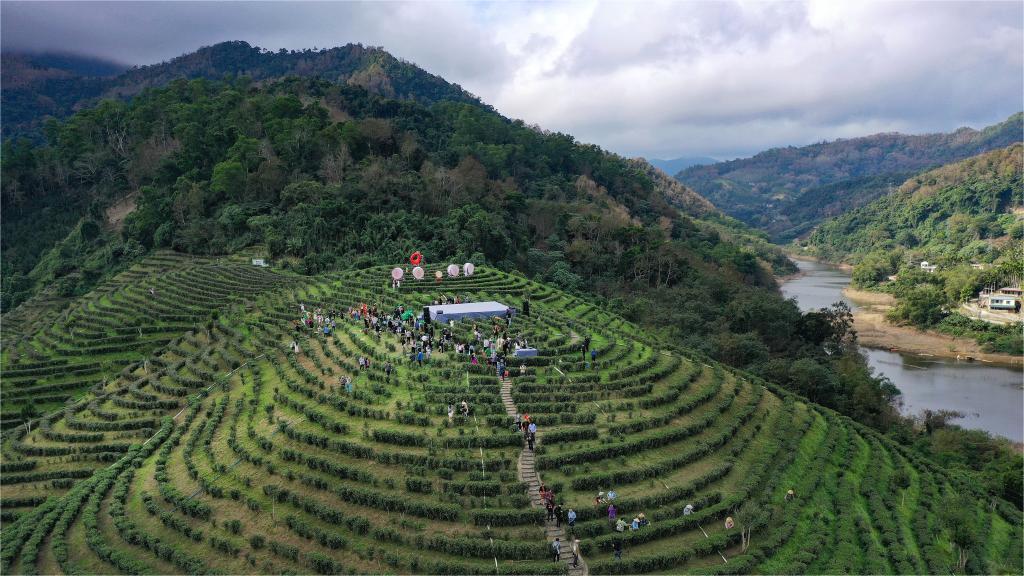Ancient Miao village sees renewal, growth in SW China's Guizhou
Langdeshang, a Miao village in Leishan county, located in the Qiandongnan Miao and Dong Autonomous Prefecture of southwest China's Guizhou Province, serves as a prime example of the county's commitment to protecting and developing its traditional villages.
Leishan county is home to 154 quaint and distinctive ethnic-minority villages, featuring over 10,000 traditional residential dwellings. This abundance of heritage sites has earned it the nickname the "museum of traditional villages without walls."

Photo shows the ancient building complex of Xijiang Qianhu Miao village in Leishan county, Qiandongnan Miao and Dong Autonomous Prefecture, southwest China's Guizhou Province. (Photo courtesy of the Publicity Department of the Communist Party of China Leishan County Committee)
Tourism has emerged as the county's pillar industry, especially since 68 ancient villages were added to the List of Traditional Chinese Villages. The tourism sector now accounts for over 60 percent of the county's GDP.
Nestled in lush mountains, the Miao village, with a history spanning more than 500 years, is situated beside a clear river. It boasts traditionally arranged wooden stilt buildings, winding lanes, waterwheels, and ruins of ancient walls and passes.
"The original style of the ancient village has been preserved," said Chen Shangfu, Party branch secretary of Shanglangde village.
In 1987, the Miao village began promoting cultural tourism. Since then, it has welcomed over 1 million tourists. In 2001, the ancient building complex of the Miao village was designated as a major historical and cultural site protected at the national level.
The successful protection and development of the village was achieved through the collaboration of all relevant parties.
Chen Nini, director of the housing security center at Qiandongnan's housing and urban-rural development bureau, explained that the prefecture implemented a five-tier cooperation system at the prefecture, municipal, county, town, and village levels to promote the protection and utilization of traditional villages.

Photo shows Langdeshang, a Miao village in Leishan county, southwest China's Guizhou Province, enveloped in mist. (Photo/Chen Peiliang)
"Currently, 415 villages in our prefecture have been added to the List of Traditional Chinese Villages, the highest number among China's prefecture-level areas," the official said.
The prefecture enlisted professionals from the China Academy of Urban Planning and Design to create a protection plan for its traditional villages.
Chen Shangfu stressed the importance of inspiring the villagers' enthusiasm, initiative, and creativity while also stimulating their intrinsic motivation as the key to preserving and developing traditional villages. The official credited the success of Langdeshang to scientific planning, early implementation, and, above all, the tangible benefits it provides to local residents.
To effectively protect traditional and ethnic-minority villages, Leishan county compiled a comprehensive guidebook detailing the styles of rural residential buildings. This guidebook provides references and guidance for aspects like architectural structure, building height, and exterior design.
"Blending the ancient elements of traditional villages with modern aspects is key to enhancing public awareness about their preservation and expanding opportunities for their protection," said Li Xufei, director of the Village Protection and Construction Center affiliated with Leishan county's housing and urban-rural development bureau.
Additionally, Leishan has constructed new residential quarters to address the challenges posed by population growth and the need to protect traditional villages.
"Thanks to the collaborative efforts of various parties, we established a new residential quarter adjacent to the village," said Chen Shangfu. To date, 23 wooden buildings have been erected in the new residential quarter. He is hopeful that in the process of protecting ancient buildings, new spaces and opportunities for the preservation and inheritance of traditional culture can also be created.
In Langdeshang, unused houses have been transformed into cultural venues. These include a lusheng (a type of reed-pipe instrument) performance space, a village history museum, and a center for handicrafts. These venues showcase Miao embroidery, silver jewelry, batik, and other local products and skills. Additionally, the village promotes the preservation of traditional skills and intangible cultural heritage by running programs and partnering with colleges to train young people in these arts.
Seizing the opportunity presented by the construction of digital state- and provincial-level traditional village museums, Qiandongnan has implemented intelligent protection for its traditional villages. To date, the prefecture has completed 126 digital traditional village museums.
"The protection of traditional villages involves more than just their layout and architectural styles. It also includes the systematic preservation of intangible cultural heritage, cultural spaces, and the cultural ecological environment," said Yang Yongfu, head of the development center for the prefecture's cultural ecology protection zone.
To better promote Langdeshang, the local government established a tourism company in 2016, focusing on building a distinctive brand of rural tourism.
"We collaborate with 30 to 40 travel agencies and attract an average of over 1,000 tourists each day," said Zhao Youxin, an executive at the tourism company.
To encourage broader participation in tourism services, Langdeshang has implemented a points-based scheme. Under this scheme, participants in various performances receive monthly bonuses, Zhao explained.
"Our company directly subsidizes 100,000 yuan ($14,060) per month. If more performances are staged, there will be additional rewards. On average, each household can increase their income by 7,000 yuan per year from this initiative alone," Zhao added.
Since 2020, Qiandongnan has implemented a tailored system, categorized and classified based on local conditions, to protect and utilize traditional villages. This approach aims to prevent uniform competition. Simultaneously, there has been a gradual merging of traditional village resources with rural tourism, ecological healthcare, study tours, sports events, and other activities to revitalize the countryside.
"Qiandongnan is a place where nature and culture harmoniously blend. The traditional villages in our prefecture are like 'museums without walls,'" Yang noted.
Photos
Related Stories
- Collective sheep farm fattens wallet in Chinese village
- Grassroots sports events empower rural revitalization
- Art reshapes rural scene in SW China village
- Urbanites find nostalgia in old village houses
- China's thriving rural tourism attracts global attention
- Shanxi strengthens protection of traditional villages and old castles
Copyright © 2024 People's Daily Online. All Rights Reserved.









